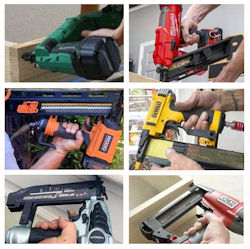Nail Gun Basics
Types of Nail Guns
Nail guns, or nailers, are power tools used to drive nails into various materials, such as wood, metal, and concrete.
Many types of nail guns are available on the market today. They have replaced hammers in wood frame construction. Three types of nail guns used on construction sites:
- pneumatic (compressed air),
- powder-actuated (explosive cartridge), and
- electrical.
Open the link to see a list of common types of nail guns.
- Framing nailer: This type of nail gun is designed for heavy-duty projects and can drive large, long nails into tough materials such as framing lumber and engineered wood products.
- Finish nailer: A finish nailer is used for lighter, more delicate work, such as installing trim, molding, and baseboards.
- Brad nailer: A brad nailer is used for even more delicate work, such as attaching thin strips of wood or decorative trim to furniture or cabinetry.
- Pin nailer: A pin nailer is the smallest type of nail gun and is used for very fine work, such as attaching delicate trim or securing small pieces of wood.
- Roofing nailer: As the name suggests, a roofing nailer is designed for roofing work and can drive long, thin nails into shingles or other roofing materials.
- Flooring nailer: A flooring nailer is used specifically for installing hardwood or engineered flooring, and can drive nails at the proper angle and depth to secure the planks in place.
- Palm nailer: A palm nailer is a handheld nail gun that can be used in tight spaces where larger nail guns won't fit, such as between studs or joists.
They are powerful, easy to operate and boost productivity for nailing tasks. They are also responsible for an estimated 37,000 emergency room visits each year – 68% of these involve workers and 32% involve consumers.
Struck-by-flying-object injuries, typically puncture wounds to the hands and fingers are the most common accident events. Nail guns can produce nail velocities as high as 1,400 feet per second penetrating stressed concrete up to .4 inches (10 cm).
When nail gun accidents do occur, the injuries are often not reported or given proper medical treatment.
Knowledge Check Choose the best answer for the question.
1-1. What is the most common nail-gun accident?
You forgot to answer the question!

